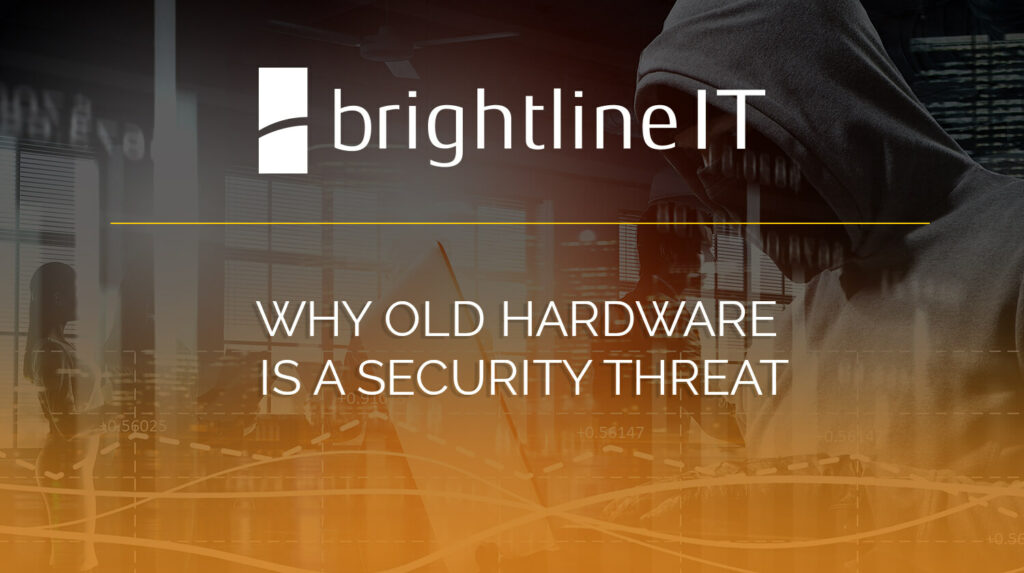Many of us understand that outdated software has known security vulnerabilities. What about hardware?
When most of us think about cybersecurity vulnerabilities, the threats that come to mind are those that target software. These are not only the most apparent to the average user, they’re also the ones that frequently make headlines. For many businesses, protecting their IT assets from threats that exploit weaknesses in software has become an accepted expense.
However, what many businesses may not realize is that outdated hardware also poses a significant security threat. Businesses that put off upgrading their hardware due to the added expense could find themselves paying for it several times over in order to recover from a cyber attack. Security breaches are not only expensive in themselves, they can also damage an organization’s reputation, leading to a loss of business.
If you’re wondering whether your business needs a hardware upgrade, here are four ways that old hardware can lead to security risks for your business.
1. Support for old hardware phases out over time.
All software programs come with minimum operating requirements. As hardware improves, software programs become more advanced in order to take advantage of the new efficiencies. What this means is that, as hardware ages, it may no longer be able to run the new software versions.
Eventually, the companies developing software stop supporting old versions of a program. When this happens, it means those old programs no longer receive updates and security patches. Any security holes will go permanently un-mended.
In other words, in order to run the most up-to-date programs, the underlying hardware must itself be up-to-date.
2. Old hardware can’t access new security features.
Staying up to date isn’t just about installing the latest security patch. It’s also about taking advantage of the newest cybersecurity tools the market has to offer. These features have included advanced encryption standards, or more recently, biometric features, such as face or fingerprint scans.
In some cases, the security advances of new hardware involve removing flaws in old systems that no longer meet modern standards. For instance, some early IoT devices came set with default passwords, which many companies failed to update. While modern devices don’t usually have this security flaw, businesses using old technology may not even be aware of this vulnerability, or of the need to remedy it.
3. Exploitable backdoors.
When most of us buy hardware, we expect it to be secure. However, in some notable recent cases, security researches have discovered backdoors left by manufacturers, malicious third parties, or even government entities that pose grave risks to consumers.
Hardware backdoors are code inside hardware or firmware that undermine the security of a computer chip or circuitboard. Backdoors require physical access to the hardware during the time of production, but once implanted can be difficult to detect or remove.
The threat of backdoors, planted by malicious agents at a vulnerable stage in the hardware production supply chain, is significant enough that the United States Department of Defense is working to develop standards for evaluating the security of hardware components along each production stage. Researchers are also looking for ways to use verify the integrity of computer chips, either through verifiable computing, or through non-destructive reverse engineering.
4. Known hardware vulnerabilities.
Finally, some vulnerabilities that have made headlines recently, including a flaw affecting Intel x86 microprocessors, IBM POWER processors, and some ARM-based microprocessors. Because this flaw runs at the hardware level, it bypasses traditional security software, including encryption programs.
Similarly, Nvidia, a company that designs graphics processing units for gaming companies and other professional markets, has also disclosed a series of flaws in their GPU display drivers which leave them vulnerable to a range of cyber attacks.
To protect themselves from known vulnerabilities, businesses should be proactive in determining whether their systems run any hardware using these chips or processing units, and should replace, patch, or upgrade these systems as quickly as possible.
Outdated hardware comes with risks beyond cybersecurity.
The security risks inherent in old hardware systems are serious enough to keep many businesses on their toes. However, there are many more reasons why businesses should not hesitate to replace outdated hardware. These include:
- Lost data. Old systems are more prone to crash unexpectedly, which can result in files not being backed up, becoming corrupted, or otherwise being unrecoverable.
- Lost productivity. Lost data necessarily leads to lost productivity. But even when a system doesn’t crash, sluggish hardware can slow down a worker’s day.
- Unexpected downtime. If hardware fails in the middle of a work day, it can quickly grind a project to a halt, leaving workers unable to complete tasks until their systems are restored.
- Greater liabilities. Many compliance regulations include hardware requirements, and even when a business isn’t required to maintain systems at a certain level, failure to do so can leave them exposed to higher insurance costs or potential legal liabilities.
In short, while replacing hardware is often a significant capital expenditure, the financial risks to your business from leaving old software in place are too great to ignore.
Contact Brightline for help upgrading your business hardware.
If you haven’t updated your hardware recently, it may be time for an audit. Our team can work with your business to create an inventory of your hardware resources that will give you a full picture of what systems are secure, and which are at replacement level. We can also help you keep track of your hardware assets moving forward, so that you no longer have to worry about whether or not your systems meet the security standards necessary to keep your business and your clients safe. Contact us today to get started.
